Flatbed trailers are invaluable assets for various industries, including transportation, construction, and logistics. However, the protection of the cargo carried by these trailers is of paramount importance, particularly in adverse weather conditions. This guide provides a detailed methodology for covering your flatbed trailer with tarps, ensuring maximum protection and security for your load.
Understanding Flatbed Trailers and Tarps
Types of Flatbed Trailers
- Standard Flatbed Trailers: The most common type, ideal for easy loading and unloading of goods.
- Step Deck Trailers: These have a lower deck that can accommodate taller cargo.
- Drop Deck Trailers: These are crafted for extra height but maintain a standard flatbed structure.
- Extendable Flatbed Trailers: Designed to carry oversized loads, these trailers can be extended to fit longer cargo.

Choosing the Right Tarp
To effectively protect your cargo, it is essential to select the appropriate tarp. Key factors to consider include:
- Material: Look for heavy-duty materials like vinyl or polyethylene for durability.
- Weight Capacity: Ensure the tarp can withstand the weight and weather conditions it will face.
- UV Resistance: Opt for tarps that provide UV protection to prevent sun damage.
- Waterproofing: A waterproof tarp keeps cargo dry, particularly during rain.
Preparing Your Flatbed Trailer for Tarping
Before covering your flatbed trailer, take the following preparatory steps to ensure an effective tarp application:
1. Inspect the Trailer Surface
- Cleanliness: Remove any debris, dirt, or rust from the surface to prevent damage to the tarp.
- Condition of the Trailer: Check for any structural issues that may affect tarp placement.

2. Measure Your Load
Accurate measurements are crucial for an effective tarp configuration. Measure the height, width, and length of your cargo, accounting for any overhanging sections.
3. Gather Necessary Tools and Equipment
Ensure you have the following tools at your disposal:
- Tarps (appropriate size and material)
- Bungee cords or tie-down straps
- Rope or ratchet straps
- Gloves (for safety)
Step-by-Step Guide to Covering Your Flatbed Trailer

Step 1: Positioning the Tarp
- Unroll the tarp and position it over your cargo, ensuring it covers the entire area.
- Allow for at least one foot of excess tarp on each side for secure anchoring.
Step 2: Securing the Tarp
Using Bungee Cords
- Attach bungee cords to the trailer’s anchor points.
- Stretch the cords through the tarp’s grommets and secure them back to the anchor points, ensuring a tight fit.

Using Ratchet Straps
- Weave ratchet straps through the grommets at multiple points along the tarp’s edge.
- Tighten the straps gradually, avoiding overtightening that could damage the tarp.
Step 3: Preventing Flapping in the Wind
To reduce wind resistance and prevent the tarp from flapping:
- Use Tarp Clips: These can clamp the edges of the tarp to prevent movement.
- Add Weight: Consider adding weights or sandbags along the edges of the tarp, especially in windy conditions, to keep it in place.
Step 4: Ensuring Complete Coverage
Check to verify that the tarp completely covers the cargo from all sides. Ensure there are no gaps, which could expose your load to weather elements.

Step 5: Final Inspection
Before hitting the road, perform a final inspection:
- Check the Tension: Ensure that all bungee cords or ratchet straps are tight and secure.
- Look for Shifts: Make sure the tarp has not shifted during the securing process.
- Examine Fastening Points: Inspect the secure points for strength and effectiveness.
Maintenance Tips for Tarps
Regular Cleaning
- Remove debris and dirt to prolong the lifespan of the tarp.
- Use a gentle soap solution and a soft brush.

Storage Guidelines
- Store tarps away from direct sunlight to prevent deterioration.
- Roll, rather than fold, to avoid creases that may weaken the material.
Routine Inspections
- Check for any signs of wear and tear, especially after each use.
- Repair any holes or damages promptly to maintain protection capabilities.
Common Issues and Solutions

Issue 1: Tarp Slipping Off
Solution: Ensure you’re using high-quality tarps with reinforced grommets and secure them tightly using a combination of bungee cords and ratchet straps.
Issue 2: Water Accumulation
Solution: Ensure a slight slope while covering your cargo to avoid flat areas which can collect water. Additionally, using a tarp with reinforced seams can reduce water penetration.
Issue 3: Tarp Damage Over Time
Solution: Opt for tarps with heavy-duty materials and UV resistance. Regular maintenance and inspections can also extend the life of tarps significantly.

FAQs About Covering Flatbed Trailers with Tarps
Q1: How do I know what size tarp to buy?
A: Measure the length and width of your cargo, then add at least one foot to each dimension to ensure complete coverage.
Q2: Can I use any tarp for my flatbed trailer?
A: No, it’s best to use heavy-duty, waterproof, and UV-resistant tarps specifically designed for covering flatbed trailers.

Q3: What if it’s windy while I’m tarping?
A: Wait for calmer conditions if possible. If you must tarp in the wind, use additional securing methods such as sandbags along the edges.
Q4: Are there tarping systems available for flatbed trailers?
A: Yes, there are automatic tarping systems designed for easy and secure covering of cargo. These can save time and labor.
Conclusion
Covering your flatbed trailer with tarps is not merely an afterthought; it’s an essential practice to safeguard your cargo against the unpredictabilities of weather and environmental factors. By following the detailed steps outlined in this guide, selecting the appropriate tarps, and employing effective securing methods, you can ensure that your load remains protected, secure, and ready for delivery.
Regular maintenance and inspecting both your trailer and tarps will enhance durability and performance. Appreciate the simplicity of a well-covered flatbed trailer, and you’ll reap the rewards in efficient delivery and customer satisfaction. Ensure your investment remains intact with the right knowledge, tools, and procedures for tarping success.



